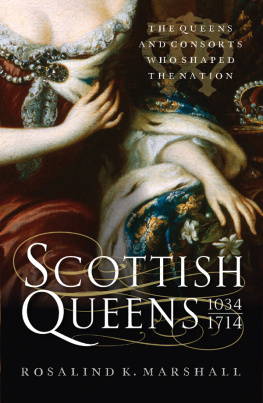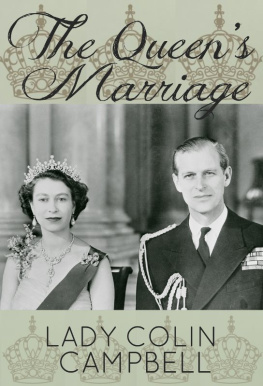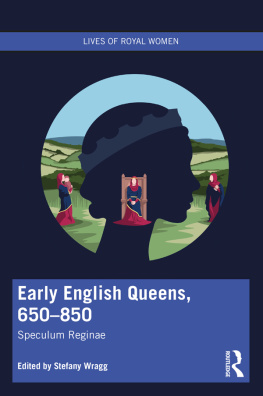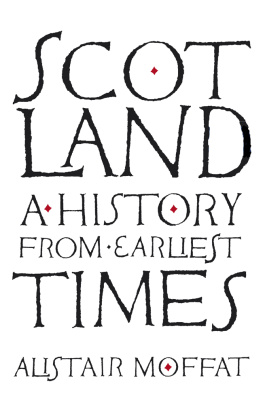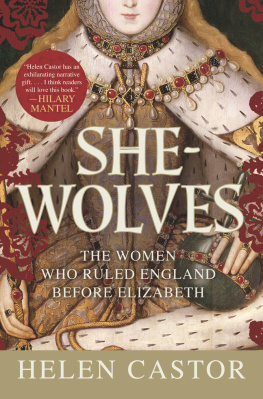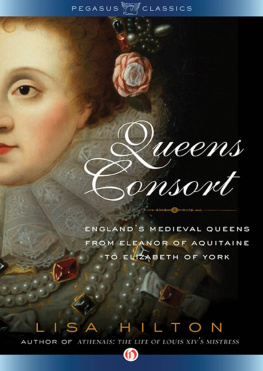Contents
Guide
SCOTTISH QUEENS
10341714

This edition published in 2019 by
Birlinn Ltd
West Newington House
10 Newington Road
Edinburgh EH9 IQS
www.birlinn.co.uk
First published in 2003 by Tuckwell Press
Copyright Rosalind K. Marshall 2003
ISBN 13: 978 1 788851 84 8
British Library Cataloguing in Publication Data
A catalogue record for this book is available on request from the British Library
The right of Rosalind K. Marshall to be identified as the author of this work has been asserted by her in accordance with the Copyright, Design and Patent Act 1988
Printed and bound by Clays Ltd, Elcograf S.p.A
for my friend Dana Bentley-Cranch
LIST OF CONTENTS
LIST OF ILLUSTRATIONS
St Margarets Chapel, Edinburgh Castle, exterior
St Margarets Chapel, Edinburgh Castle, interior
Dunfermline Abbey, where St Margaret was buried
Balmerino Abbey, founded by Queen Ermengarde
Base of St Margarets shrine, Dunfermline Abbey
Edinburgh Castle, where Margaret of England spent her early married years
Jedburgh Abbey, where Queen Yolande married Alexander III
Kildrummy Castle, where Queen Elizabeth stayed on her flight north
Dingwall Castle, where Queen Euphemia was brought up
Dundonald Castle, Queen Euphemias home after her marriage to Robert the Steward
Moot Hill, Scone, where Queen Euphemia was crowned. The building is of a later date
Lady dictating to her secretary, as Queen Annabella did. From a medieval manuscript
James I, husband of Queen Joan
James II, husband of Queen Mary of Gueldres
The remains of the Collegiate Church of the Holy Trinity, Edinburgh, founded by Queen Mary of Gueldres
Ravenscraig Castle, built by Queen Mary of Gueldres
James III, husband of Queen Margaret of Denmark, by an unknown artist
Stirling Castle, where Queen Margaret of Denmark spent her final years
Cambuskenneth Abbey, where Queen Margaret of Denmark was buried
James IV, husband of Queen Margaret Tudor, by Daniel Mytens
Archibald Douglas, 6th Earl of Angus, engraved by Laurie after F. Clouet
Queen Margaret Tudor with the Duke of Albany and possibly Harry Stewart, Lord Methven, by an unknown artist
Eleanor of Austria, stepmother of Queen Madeleine, who grew up in her household
James V, husband of Queen Madeleine, by an unknown artist
Queen Madeleine by Corneille de Lyon
Holyrood Abbey, where Queen Madeleine was buried
Queen Mary of Guises Book of Hours
Queen Mary of Guise by Corneille de Lyon
St Andrews Cathedral, where Queen Mary of Guise married James V
The Palace of Holyroodhouse, drawn by an English spy in 1544
Linlithgow Palace, showing the window of the room where Mary, Queen of Scots was born
Mary, Queen of Scots, aged about sixteen, by Franois Clouet
Francis II of France, first husband of Mary, Queen of Scots by an unknown artist
Henry Stewart, Lord Darnley, second husband of Mary, Queen of Scots, by an unknown artist
James Hepburn, 4th Earl of Bothwell, third husband of Mary, Queen of Scots, by an unknown miniaturist
The execution of Mary, Queen of Scots, by an unknown Dutch artist
Queen Anne of Denmark, 1595, attributed to Adriaen Vanson
James VI and I, husband of Queen Anne of Denmark, 1595, attributed to Adriaen Vanson
Dunfermline Palace, Queen Anne of Denmarks favourite Scottish residence, with the abbey in the background.
Prince Henry Frederick, Queen Anne of Denmarks eldest son
Charles I, shortly before he married Queen Henrietta Maria, by Daniel Mytens
Queen Henrietta Maria, engraved after a painting by Daniel Mytens
Queen Catherine of Braganza, by an unknown artist
Charles II, husband of Queen Catherine of Braganza, engraved by R. White after Sir Godfrey Kneller
Queen Mary of Modena by Willem Wissing
James VII and II, at about the time of his marriage to Queen Mary of Modena, by an unknown sculptor
James VII and IIs wedding suit
Prince James Francis Edward, Queen Mary of Modenas only surviving son, by Nicholas de Largillirre
Princess Louise, Queen Mary of Modenas only surviving daughter, by a follower of Largillirre
William II and III, husband of Queen Mary II, after Sir Godfrey Kneller
Queen Mary II after Willem Wissing
Queen Anne as a child, by an unknown artist
Anne Hyde, Duchess of York, mother of Queen Mary II and Queen Anne
Queen Anne as a young woman, by Willem Wissing and J. van der Vaardt
Prince George of Denmark, Queen Annes husband, engraved by J. Houbraken after Sir Godfrey Kneller
William, Duke of Gloucester, Queen Annes longest surviving son, engraved by J. Houbraken after Sir Godfrey Kneller
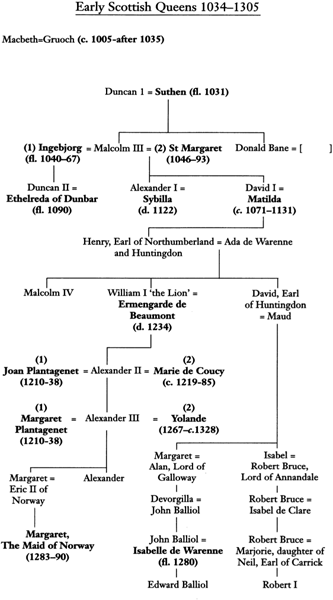

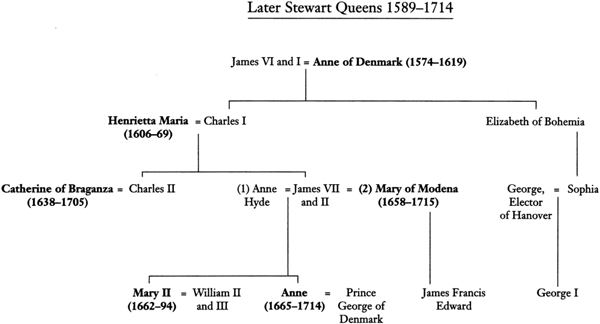
PREFACE
L eaving aside the wives of Duncan I and Lulach, neither of whom was necessarily alive when her husband reigned, there were thirty-one Scottish queens from the accession of Duncan I in 1034 until the death of Queen Anne in 1714. Four were queens in their own right, and the other twenty-seven were consorts. This is obviously a very small, extremely lite group and in theory its members should be much better documented than any other women of the past. In practice, however, they are almost equally elusive. Our knowledge of the wives of kings before the early sixteenth century is fragmentary, and even the later consorts are overshadowed in the records by their husbands. However, when the surviving details of their careers are gathered together, we have not only an entertaining procession of vivid personalities. We may also gain a better understanding of what queenship meant in Scotland.
When Tuckwell Press invited me to write this book, I had to decide how many queens to discuss. Coming up to the present day within the allotted number of words would have meant condensing the earlier chapters to the point where I lost much valuable information. I could have stopped when Anne of Denmark disappeared over the Border in 1603, but I had two reasons for continuing beyond that point. I thought it worth emphasising that exotic consorts such as Henrietta Maria and Catherine of Braganza were Queens of Scots, and I wanted to remind people of the frequently forgotten fact that both Mary of Modena and Queen Anne spent some months in Scotland, albeit before they became respectively Queen Consort and Queen Regnant. I therefore decided that Anne, the last Stewart monarch, was the appropriate subject for my final chapter. Subsequent queens did not come north until Victoria developed her passionate love of the Highlands, after which queens consort and regnant alike had a relationship with Scotland which was in part formal, carrying out official engagements here as in the south, and in part personal, relaxing at Balmoral and enjoying some measure of private life.
Throughout the text I have modernised spelling, translating into English where necessary. After due consideration, I decided to use the names by which the various queens and others seem to be best known, hence the apparent inconsistency of Marie de Coucy and Mary of Guise. Anglicising Don Carlos into Prince Charles, for instance, could have conjured up the wrong mental image in the readers mind, and so he retains his Spanish title. Names of publications abbreviated in the notes are to be found in full in the Bibliography, which does not list those sources cited only once.

